Elinor’s 1918 Diary Pages (also see family tree associated with Georgia Ave household during Spanish Flu, Lorain, Ohio 1918)
Diary starting Sept. 1. 1918. written into a black leather type small bound notebook
Audrey & George were-married Oct. 6. 1911
Frank & Ruby were-married July 27. 1911
Elbert & were-
Gertie & were-
[note: Elinor left Elbert & Gertie space to add their spouses if/when they married. Neither of them did and Elinor ends up living most of her adult life with Elbert]
Fred & Ethel were married May 26, 1918.
Nellie & John were married June. 28. 1918.
Elinor & Frank were married May 17. 1920.
Sept. 1. Nellie [Bonney] & John [McKinley Harnish] moved home yesterday & John has to go to camp soon.
Sept. 2. Martha [Carlisle] was 6 yrs. old June 3 [1918] & will be in the first grade tomorrow.
Sept. 3. Nellie [Harnish nee Bonney] started teaching at Fairborne School today, this will be her third year of teaching [Nellie started teaching Sept. 2016]
[note: Sept.4. through Sept 18 all listed at the left margin but without any narrative or text.]
Sept.19. Fred’s Birthday.
Sept.24. Audrey started to work for Walton & Da
Sept.27. Audrey stayed home & did the house work my cold today is so bad.
Sept.29. Haven’t worked today. Pa & Elbert and Frank pulled out Had His Way & Not So Bad today. Our New Preacher Preached his first sermon this Morn. Rev. Campbell
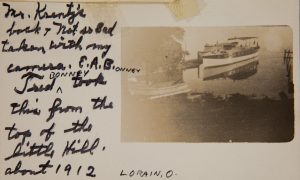
1912, “Mr Krantz’s back and Not so Bad taken with my camera. E.A.Bonney, Fred Bonney took this from the top of the little Hill, Lorain, O”
Sept.30. Well I worked hard today I canned 12 qts of tomatoes & Chow Chow. & did all my house work as usual. [note: Chow Chow is a condiment relish made mostly of vegetables and cabbage and canned]
Oct. 1.[18] I were to ill to work today
Oct.2. I didn’t do much to day Gertie was home with a sore toe.
Oct.3. I worked hard to-day swept and finished my ironing I got a letter from annabell & I wrote three letters tonight.
Oct.4. Well I wish I were well, but, I havent been able to work today.
Sat. Oct.5. Couldn’t work today, very much.
Oct.6. Sun. Pa & the boys pulled out Dr. Fredricks launch today. I helped get dinner. Gertie dressed 4 chickens & I skined 3 more & she dress them out I pealed the potatoes & Audrey made the biscuit I help fry the chicken & make the gravey & this morning at 3 a.m. the whistles & bells and everything that could make a noise did. so They received news that Bulgaria has surrendered, and oh, such a blow out.
Mon. Oct.7. Audrey had to stay home to look after the work today.
Glen Haught phoned yesterday and said his father had been killed on Thurs. Oct.3. and engine struck him, then run over him cutting him all to pieces. Pa went to Cleveland to the funeral today, to be held at the home a 2.p.m. this after noon.
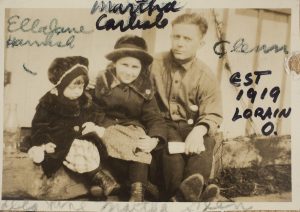
1919~ “Ella Jane Harnish Martha Carlisle Glenn est 1919 Lorain O.” (presumably Glenn Haught also in Elenor Bonney (Babcock) diary.
I went to town in a car & back, I took a treatment; cost 1.00 cost 1:00
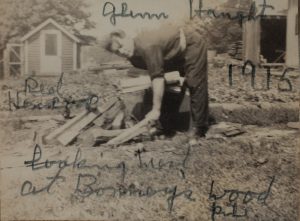
1915 Glenn Haught “looking west at Bonney’s wood pile (in front of the Red Hen Coop” also mentioned in Elenor Bonney’s 1919~ diary.
Tues. Oct.8. Martha is home with a cold. Dr think I have Spanish flue. and I think so myself & I think Martha has it now, poor child.
Influenza Epidemic of 1918
A deadly outbreak of Spanish Influenza, which reached epidemic proportions, spread from Europe to the United States and to Ohio in 1918. Approximately 500,000 of those with the disease died from the virus in the United States. The epidemic seemed to be particularly bad in army camps, where the men lived in close proximity to each other. Within only two months, more than 300,000 soldiers had contracted the illness. Approximately twenty thousand troops died of influenza.
In Ohio, Camp Sherman was affected more by the epidemic than any other training camp in the nation. The disease swept through the camp in the late summer and early fall. Almost twelve hundred men died at Camp Sherman before the epidemic ended. Although the nearby community of Chillicothe was quarantined to prevent the spread of the epidemic, some people outside of the camp still became ill and died of the disease.
Communities across Ohio experienced illnesses and deaths from the influenza at this time. During the last week of October 1918, 1,500 Ohioans died. Between October 1918 and January 1919, almost six hundred Dayton residents perished. In an attempt to stop the spread of the disease, many colleges temporarily closed their doors. In some cases, campus buildings were made into makeshift hospitals to treat those who had contracted the illness. Many other parts of the country also experienced tragedy as a result of the influenza epidemic of 1918. (from Ohio History Central)
Wed. Oct.9. Had to work today but its took all the strength I had, I didn’t feel able to wash the supper dishes so hade to wash them in the morn. as the girls didn’t wash them.
Thurs. Oct.10. I have worked all day I feel a little better, but oh so weak. Elbert and Pa are getting bad colds and Im sorry and my new neighbors are eating my chickens. Gertie did washing tonight and I have to wash tomorrow, if I can, I’m going to try. Mrs Bostinick & her family have moved into their new furnished rooms for the winter. I got my new shoes today 3.95 from Sears Roebuck & Co. & they fit me good. I wahed today. schools all shut down, to much in-flu-enza.
Fri. Oct.11. I have an order coming from Sears.
Sat.Oct.12. Got my shoes they are fine.
Sun . .13. Have felt so bad to day & so have some of the rest, the Dr. thinks I have In-flu-enza, I know something have got me, I’m so weak.
Mon.Oct.14. To tired to do much, but have pickled, 5 gal. of pears, and cut out three corset covers, and got supper & wahed the dishes.
Tue.Oct.15. I have my corset covers all done but finishing, and I’m so tired, Oh, No, one Knows.
Wed. Oct.16. Pa has been working for a colored family, carpenter work Elbert is sick I guess he has the flu he sure looks sick. We/are having quite nice weather now.
Oct.17. Well I have worked only because I felt I had to, I sure do feel bad and Martha isn’t feeling well & I have to look after her nights to. Elbert feels worse.
Oct.18. Elbert feels terrible bad, Pa don’t feel very well, & I didnt feel as if I could work.
Oct.19. I talked Elbert over, & he went to Dr. Easton & took a treatment today, he’s sick.
Oct. 20. Gertie is sick today, We most have a hospital here. gloomy day for all.
Oct.21. Gertie worse fever 102 1/2 had Dr. McGoraney Elbert went to Dr. Easton but don’t seem any better, Pa & Audrey working yet, Martha is Playing around yet. I did white wash & baked 8 loaves of bread Nellie did house work, but don’t feel very well. I went to town with Audrey && Frank, got ride home.Oct.22. Elbert is better, he took treatment to-day, Gertie better fever 101 1/2 today Audrey Pa & Martha don’t seem any better, Nellie sick alnight, better tonight. I did lot of work & finished my wash. Fred is sick.
Oct 22. Ethel’s mother phoned today said Fred was better, all the rest well. Audrey got job in shipyard today $60 per. mo. I came near fainting today, to tired. Pa worked home today I wrote a letter to Dan & Nellie packed box for John.
Oct.23. Gertie’s fever 102. she’s terrible weak. gave her medicine until 12 midnight then pa took care of her untill Audrey got up, then I got up at 8-30. and cared for her untill 3-30.am
Oct 24. Cousin Lucy Scott was her yesterday after noon, & Bell is going to marry a man that is turning out the dollars she is 30 & he 24) Martha was taken worse yesterday fever 104, no beter today. Gertie’s fever 103 1/4 today she’s in bad shape. I set up until 3-30 am. & feel tired out.
Oct.25. Well I got up at 12 to such a day Martha is better but Gertie’s fever 104 1/2 & I’ve done every think I know how to I set up until 4-30.am. and then pa took car of her.
Oct.26. got up 2-30 pm been on the jump most every minute. Gertie’s fever 104 3/4. Martha better.
Oct.27. Gertie is very low her fever still so high. I received a card from Annabel, tell me she has just lost her baby boy, poor girl, she is sure having her troubles. Martha’s back to her regular feed, Fred not working yet, Mrs Noderer call me today. Elbert not working yet, his eyes still bad. Pa & the boys E & Frank pulled out Carl 8. today.
Mon.Oct.28. Well Gertie’s fever is 102 today and she seems better but terrible weak. I don’t feel very good today & have bad sore throat. Nellie feels better Audrey worked in the shipyard today pa bought Gertie new blanket & comfort today.
Oct.29. I am sending and order to Sears today. I thank God for the many blessings he has given me, and pray he will forever Keep me close in His care, and make me what he wants me to be & help me to do & be each minute just as He sees best, and I pray He will make me happy and content in doing and abiding in His Holy Will. I ask in the name of the Father, Son & Holy Ghost, amen.
Oct.30.Wed. went to bed at 5-30 this am. went to sleep after 6 and got up 4.p.m. Gertie’s fever was 101 4/5 today is seems better and rests better at night for the past two nights. received letter from dan today Oct.30.
Oct.31. I have written four letters tonight one to Dan one to Flora Glover one to Iva Comstable & one Annabel Mariner. I went to bed at 5-30 a.m. and slept until noon, then after dinner I washed until supper the ate my supper and washed up the dishes, took care of Gertie & done several odds & ends & then wrote a letter to Mr Emil Quanetrom, 10418ave.H. East Side Sta., Chicago Ill. for Gertie. Nellie is up yet it’s 12-30 p.m. she is expecting to go see John, if he can’t come home, she’s looking for a telegram tomorrow morning. I have got to get up at noon & finish my washing. Gertie’s fever 100
Nov.1. Gertie’s fever 99 1/5 Nellie got her telegram. & don’t have to go, John is going to be there for a while yet. Pa finished the washing & Nellie helped him. I feel alive
Nov.2. Gertie’s fever 97 1/5 I am going to bed its 1-30 a.m. I don’t feel very well myself.
Nov.3. Gertie is normal today I swept & moped the dining room & aired our bedding today.
Nov.4. Took care of Gertie cooked & done house work & sewed a little today.
Nov.5. Got things straightened up a little more today. Ruby’s baby came today 8lbs& 10 ozs.a girl. both doing well. Nellie don’t feel well.
Nov.6. Gertie doing well sit up today about 5 minutes. I did a days work this afternoon.
Nov.7. Germany surrendered today, they blew all the whistles played the band had a parade & shouted & yelled from 20 minutes two 2 p.m. until long after 12 p.m. I thank God with all my soul.
Nov.8. Well the report was not true & so they’ll have to do all the soise over. Made Gertie terrible nervous but she doing fine
Nov.9. Audrey came home early & we did quite a lot of work. but I’m so tired.
Sun.Nov.10. It fine day but I feel an unrest Well, John phoned for Nellie to come and she & pa left in time to catch the 8-50 limited for Cleveland, they expect to get the midnight train out for Columbus & then to take a care to Camp Sherman.
The Spanish Influenza Pandemic of 1918 at Camp Sherman
Hopewell Culture National Historical Park
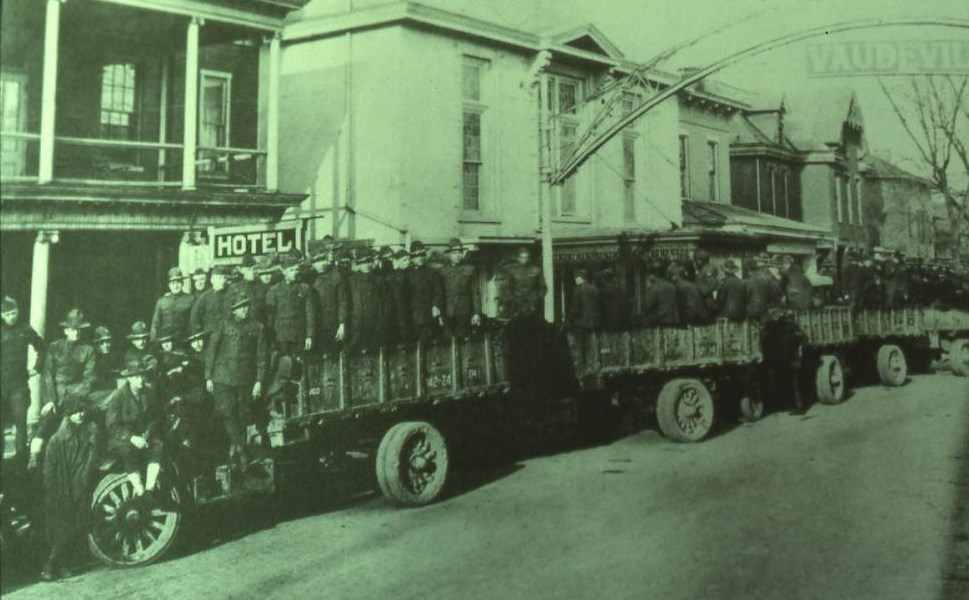
NPS Photo
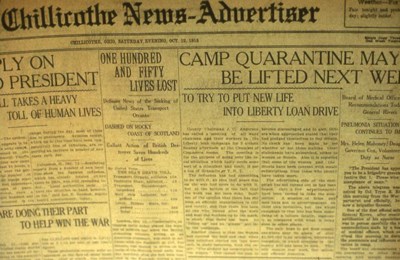
NPS Photo
While the allies battled an enemy in the fields and trenches of Europe in 1918, the entire world would have to engage and fight a seemingly invisible enemy that wasn’t isolated to war combatants on the field of battle. The Spanish Influenza Pandemic of 1918 would tally a greater mortality rate than that of all who were killed during combat in WWI. No one is quite sure where exactly the Influenza originated, but once it began to spread there was no hiding from this silent and deadly disease. Over 20 million people, almost 5% of the world population, died as this disease spread with ruthless efficiency. 43,000 U.S. soldiers, around half of those who died in Europe during the war, were killed by the influenza virus and not by a mortal enemy in combat. In the U.S. alone, over a quarter of the population would become infected and nearly 700,000 would die as a result of the disease. Conditions around the globe would mimic that of the Black Death Bubonic Plague in the 14th century. However, this strain of influenza would kill more people in one year than what the Bubonic Plague did in four total years.
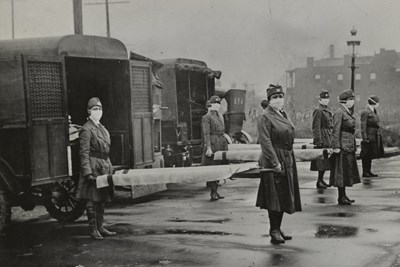
Library of Congress
A Global Killer comes Home
In Chillicothe and at Camp Sherman, the disease spread just as quickly as it did everywhere else. Thousands of residents and soldiers were infected in a very short time. Approximately 5,686 cases of influenza were documented among Camp Sherman soldiers in 1918. 1,777 of them were unable to ward off the disease and died. Statewide in Ohio, hundreds of thousands of people became infected and tens of thousands died. During one week alone in the fall of 1918, 1,541 people were confirmed to have died throughout the state.
With the high mortality rate at Camp Sherman, The Majestic Theater on 2nd Street in Chillicothe became a temporary morgue. Bodies would be “stacked like cordwood” at the theater while it was operated as a morgue. Body fluids that were drained during the embalming process ran off into the alley next to the theater giving it the dubious nickname of “Blood Alley.” Once victims’ bodies completed the embalming process, they would be transported by wagon back to the camp so they could be sent back to their hometowns by railway. As these wagons made their way through Chillicothe, funeral hymns were played to reflect the somber mood. As with all public places in the U.S., meeting places, bars and theaters were closed to try to prevent further spread of the disease. All personnel at Camp Sherman were quarantined from Chillicothe as well.
By summer of 1919, the pandemic would come to an end as the influenza ran its course and the world’s population built up an immunity towards it. This was a pandemic that the world had never seen the likes of before and hasn’t seen the likes since. While other strains of influenza have popped up through the years since 1919, the Spanish Influenza Pandemic of 1918 remains the most devastating and deadliest disease that the world has ever seen.
Mon.11. To day Germany did surrender so they said & it sounds like it Gertie is better, but the noise worrys her some.
Tue.Nov.12. & the noise still going on, I wish it were all over. I have done quite a little work today.
Wed.Nov.13. Pa & Nellie not home yet. I went to town Mon. & took a treatment & came right back, and I had ought to went today but Audrey didn’t seem to want me to.
Thurs.Nov.14. I did quite a lot of work to day. Gertie can walk to dining room now. is weak but getting along fine. Dr. here today
Fri.Nov.14. Done my usual work today
Sat.Nov.16. Well I did some straighting up & my usual work & am tired as usual.
Sun.Nov.17. Pa & Elbert pulled Kaisers launch out, this morn. Ethel here to day & League & Church
Mon.Nov.18. I washed Gertie’s clothes today & did my home work & it rained.
Tues.Nov.19. I did my white wash & home work & bought a new 1900 Washing machine & Wringer & a 1/2 bu. basket of apples tub 12.00 wringer 7.75 & apples 1.00 I paid 10.00 on tub & wringer & paid for apples . that 22.75 surprised the men some, but I neeed those articles wrung the clothes by hand the most of 17 yrs. & the old machine was wore out & we have been using a wash board for the past two yrs. I wrote a letter to Dan I wish he would write, into such stormy weather.
Early washing machines were invented back in the 1850s, but people have been doing laundry since they graduated from wearing fig leaves. Over the course of centuries, the technology for washing clothes has evolved from crude manual labor to high tech.
Laundry Before Machines
In many ancient cultures, peoples cleaned their clothes by pounding them on rocks or rubbing them with abrasive sands and washing the dirt away in streams or rivers. The Romans invented a crude soap, similar to lye, that contained ash and fat from sacrificed animals. In colonial times, the most common way of washing clothes was to boil them in a large pot or cauldron, then lay them on a flat board, and beat them with a paddle called a dolly.
The metal washboard, which many people associate with pioneer life, wasn’t invented until about 1833. Before that, washboards were made entirely of wood, including the carved, ridged washing surface. As late as the Civil War, laundry was often a communal ritual, especially in places near rivers, springs, and other bodies of water, where the washing was done.
The First Washing Machines
By the mid-1800s, the United States was in the midst of an industrial revolution. As the nation expanded westward and industry grew, urban populations mushroomed and the middle class emerged with money to spare and boundless enthusiasm for labor-saving devices. A number of people can lay claim to inventing some kind of manual washing machine that combined a wooden drum with a metal agitator.
Two Americans, James King in 1851 and Hamilton Smith in 1858, filed and received patents for similar devices that historians sometimes cite as the first true “modern” washers. However, others would improve on the basic technology, including members of the Shaker communities in Pennsylvania. Expanding on ideas begun in the 1850s, the Shakers built and marketed large wooden washing machines designed to work on a small commercial scale. One of their most popular models was displayed at the Centennial Exposition in Philadelphia in 1876.
Fast Facts: Washing Machine Trivia
- A washing machine invented in France in the early 1800s was called the ventilator. The device consisted of a barrel-shaped metal drum with holes that was turned by hand over a fire.
- One of the first African-American inventors of note in the 19th century, George T. Sampson, received a patent for a clothes dryer in 1892. His invention used the heat from a stove to dry clothes.
- The first electrical clothes dryers appeared in the United States in the years prior to World War I.
- In 1994, Staber Industries released the System 2000 washing machine, which is the only top-loading, horizontal-axis washer to be manufactured in the United States.
- The first computer-controlled consumer washer appeared in 1998. Fisher & Paykel’s SmartDrive washing machines used a computer-controlled system to determine load size and to adjust the wash cycle to match.
Electric Machines
Thomas Edison‘s pioneering work in electricity accelerated America’s industrial progress. Until the late 1800s, home washing machines were hand-powered, while commercial machines were driven by steam and belts. That all changed in 1908 with the introduction of the Thor, the first commercial electric washer.
The Thor, the invention of Alva J. Fisher, was marketed by the Hurley Machine Company of Chicago. It was a drum-type washing machine with a galvanized tub. Throughout the 20th century, Thor continued to make innovations in washing machine technology. In 2008, the trademark was bought out by Los Angeles-based Appliances International and soon introduced a new line under the Thor name.Even as Thor was changing the commercial laundry business, other companies had their eye on the consumer market, perhaps most notably the Maytag Corporation that got its start in 1893 when F.L. Maytag began manufacturing farm implements in Newton, Iowa. Business was slow in winter, so to add to his line of products, Maytag introduced a wooden-tub washing machine in 1907. Not long after, Maytag decided to devote himself full-time to the washing machine business. The Whirlpool Corporation, another well-known brand, debuted in 1911 as the Upton Machine Co., in St. Joseph, Mich., producing electric motor-driven wringer washers.
Sources
- Marton, Barry. “Washing Machine.” Encyclopedia.com. Accessed 16 Mar. 2018
- Museum staff. “The Shaker Improved Washing Machine.” Shaker Museum. 20 July 2016.
- Staff editors. “Clothes Washing Machines.” Edison Tech Center. 2014.
- Telegraph staff. “A Timeline of Inventions.” Telegraph.co.uk. 6 July 2000.
Wed.Nov.20. Thurs.21; Fri.22., Sat.23. Sun 24 & I have only done my usual work my liver is so bad
Mon.Nov.25. Helped Nellie with her dress I feel bad yet & Dan came 10-40 P.m.
Nov 26.Tue. Well I have cooked washed dishes swept & helped Nellie sew & visited with Dan.
Nov.Wed.27. Not so well today but done my worke & visited with Dan. I made 4 pumpkin pies & 2 apple & 1 big custard pie & 1 for Martha.
Nov. Thurs.28. I Made a big chicken pie for dinner & We were all Thankful but Not one ask the Blessing aloud Will God forgive?
Nov.Fri.29. Ma’s birthday she would be 61 yrs. old today, poor dear ma. I were to sick to get up much before supper. I visited with Dan.
Nov.Sat.30. Couldnt work much to day. Dan gave me 40VII::VYL f= OVLP. v=u S 722 S2 S= 2fsquare ^V=X. [note: for some reason she put this all in “code”, which was deciphered by Sara Klips and her husband Ryan] Dan bought me a box of writing paper a bottle of ink & 12 stamps & a box of chocalates a bag of nuts & a bag of oranges & apples and a news paper every day.
Dec.Sun 1. I’m sure sick, but I had a nice visit with Dan. He bought me two records. I’m sorry I couldn’t have gone to town and out to put some flower on ma’s grave.
Dec.2.Mon. Dan went to Erie Pen. today.
Dec.2.Mon. I did some washing today, I sick yet.
Tue 3. Did some more wash & baked 7 loaves of bread today & liver & hip hurt me yet.
Wed 4. Pa & I both washed today. Oh me Pa had to quit his back hurt so bad.
Thurs.5. I got a letter from Dan today & finished the washing did the sweeping & cooking & cleaned a rabbit pa shot & 3 chickens. got two eggs today. Nellie went to town Tue. & paid 6.75 on my washer & wringer. I bought 8 pair of stockings from sears & two pair of slipper, have to send 1 pr. back gave Audrey 4 pr. stockings. Nellie bought 3 balls of crochet cotton 3 balls tating threat, 6 handkerchiefs & some lace for my corset cover to, I wrote a letter tonight to Dan.
Fri.6. Elbert’s Birthday he was 36 yrs. old today I had a chicken supper for him. I am sick yet.
Sat.7. We did a little bit of every thing today.
Sun.8. I didn’t do any (work/thing) today, but went to League & Church in the evening We expect John home soon.
Mon.9. Well I felt so bad I went & took a treatment today & then went over to Miss Baumgarts to supper,it rained quite steady but not hard & Elbert came part way and met me & we came home together, Elbert isn’t very well but he works every day, 4 eggs today. Nellie is crocheting & I cut out a little underskirt for her, I feel better tonight.
Tue.10. Well I mended today I feel better but believe I ought to go/to the Dr. tomorrow. 3 eggs today
Wed.11. Elsie Wheeler’s birthday she is 23 yrs old. I mended did my house work made doughnuts & went to pray meeting. I sent Miss Baumgart a loaf of bread & some doughnuts by Elbert. I crocheted some tonight. Frank trapped a big mink last night, it was almost as large as a cat. he caught a smaller one the other day, he has 3 skunk hides or furs and 40 muskrat hides. I only got one egg today. only have 26 hens & rooster.
Thurs.12. Fri 13. Sat 14. Sun. 15. Did my work as useral. Pa & I went to Cleveland
Sun.15. in after noon, went to Houghts Glen gave me a big soldier doll for Martha.
John came home at 12-30.p.m.
Mon 16. We came home tonight had a great time, car crowded left Cleveland 4-30 p.m. & pa stood up all the way home. we got here 7.p.m. both tired. Pa had his picture taken today in Cleveland & he gave me one, they are good as natural as life.
Tue.17. I wrote a letter to Dan & one to Anna-bell tonight, I am tired.
Wed.18. Gertie and I made 24 tennis squares for Nellie, while she & John were gone today, and I did the stitching it made me sick I can’t endure much anymore.
Thurs.19. Did my house work that’s all
Fri.20. /went to town had to have Nellie come meet me the I got supper & then helped Nellie & John make sanwitches for an Epsworth League social [note the Epsworth League is a young adult Methodist association for 18-35 year olds. It started in Cleveland in 1889] I made salid dressing & spread the bread with it then Nellie picked enough lettuce from the garden, so we made 60 with ham & lettuce between two slice of bread & Salid dressing. then Martha ;& we four girls & John went to the social We rapped the sanwiches each with two olives & two pieces of [eiley?], in white crepe paper napkins and put X’mas stickers on them, then they served cofee with sugar and cream.
Sat.21. I sewed on patches & buttons & did my useral house work.
Sun.22. Cooked & made a cake & poped corn. pa got his upper plate of teeth yestersday, his gums are sore. He & Gertie went on the evening train to Mich & Nellie & John went to take care of a home for a man & his wife & children for a month. So Elbert & Audrey & Martha & I are left here to do as we please stay or go. Emil’s birth day today he is 37 yrs.
Mon.23. Nellie & John came home after dinner & stayed untill 9-15 p.m. I cut out 6 bellie bands 4 pinning blankets 3 skirts & two pink nightgowns. to night, Audrey & Elbert went to the new ship yard restraunt to see the dance & enjoy the lunch.
Tue.24. Did my house work & dressed 3 hens for dinner tomorrow, got them most boiled. No Dan came yet the naughty man.
Note: At this point Elinor begins to insert dates that apparently have weather predicted year or years prior, so it makes the diary tracking a bit confusing. This is being depicted as ( ) after each date but does not conform to the actual date for the entry.
Wed Dec.25. (Jan) X’Ma’s Francis Gibson gave me a fountain pen , its a nice one, he ate dinner with Elbert Audrey Martha & I today, I bought some fruit & candy & mints for Martha & gave her a handkerchief with crocheted edge.-
(the weather forecast) Turned cold last night spit with snow all day Cloudy all day, sunshine coming through several times during the day. westerly wind. Audrey & Martha went over to Francis home to supper & over to Gilmore’s after supper so Martha could see the X’Mas tree, they came home befor ten oclock Elbert & I spent after noon & evening alone.



